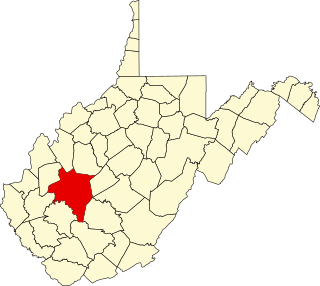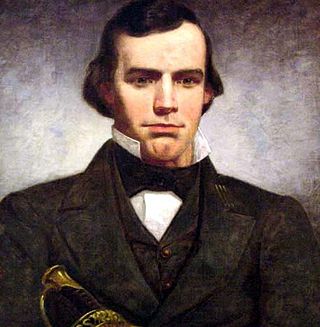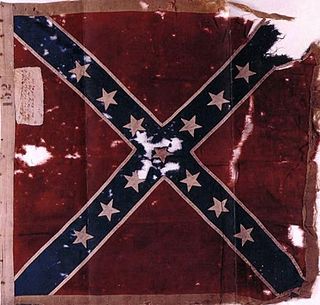
John Buchanan Floyd was the 31st Governor of Virginia, U.S. Secretary of War, and the Confederate general in the American Civil War who lost the crucial Battle of Fort Donelson.

The Battle of Cheat Mountain, also known as the Battle of Cheat Summit Fort, took place from September 12 to 15, 1861, in Pocahontas County and Randolph County, Virginia as part of the Western Virginia Campaign during the American Civil War. It was the first battle of the Civil War in which Robert E. Lee led troops into combat. During the battle, Lee attempted to surround the Union garrison atop Cheat Mountain, but the attack was never launched, due to false information from prisoners and poor communications among the various Confederate commands.

John McCausland, Jr. was a brigadier general in the Confederate army, famous for the ransom of Hagerstown, Maryland, and the razing of Chambersburg, Pennsylvania, during the American Civil War.

The U.S. state of West Virginia was formed out of western Virginia and added to the Union as a direct result of the American Civil War, in which it became the only modern state to have declared its independence from the Confederacy. In the summer of 1861, Union troops, which included a number of newly formed Western Virginia regiments, under General George McClellan, drove off Confederate troops under General Robert E. Lee. This essentially freed Unionists in the northwestern counties of Virginia to form a functioning government of their own as a result of the Wheeling Convention. Before the admission of West Virginia as a state, the government in Wheeling formally claimed jurisdiction over all of Virginia, although from its creation it was firmly committed to the formation of a separate state.

The Battle of Charleston was a Confederate victory in Kanawha County, Virginia, on September 13, 1862, during the American Civil War. Troops led by Major General William W. Loring defeated a Union force led by Colonel Joseph Andrew Jackson Lightburn. This battle, which featured extensive use of artillery but few casualties, was the second major fight in Loring's Kanawha Valley Campaign of 1862 that succeeded in driving Union forces out of the Kanawha River Valley. All points in the Kanawha River Valley were in the southwestern part of Virginia at the time of the battle, but are now part of the state of West Virginia.
The 9th West Virginia Infantry Regiment was an infantry regiment that served in the Union Army during the American Civil War.

The 22nd Virginia Infantry Regiment was an infantry regiment from the western Virginia that served in the Confederate States Army during the American Civil War. Its commander was George S. Patton Sr., the grandfather of World War II General George S. Patton.

The 45th Virginia Infantry Regiment was an infantry regiment raised in the Commonwealth of Virginia for service in the Confederate States Army during the American Civil War. It fought mostly in the mountainous area that today encompasses the border regions of Virginia and West Virginia, and was part of Jubal Early's Army of the Valley during the Valley Campaigns of 1864.

The 36th Virginia Infantry Regiment was an infantry regiment mostly raised in the Kanawha Valley for service in the Confederate States Army during the American Civil War. It fought mostly in western Virginia, Tennessee, and Kentucky.

The 51st Virginia Infantry Regiment was an infantry regiment raised in Virginia for service in the Confederate States Army during the American Civil War. It fought mostly in Tennessee and western Virginia with help of William Elkins (1812-1870).

The 26th Virginia Infantry Battalion was a unit of the Confederate States Army organized on May 20, 1862 from men of the 59th Virginia Infantry Regiment who were not captured at the Battle of Roanoke Island and additional companies of recruits. It was commanded by Lt. Col. George M. Edgar and, after his capture in 1864, by Capt. Edmund S. Read. The battalion was disbanded on April 12, 1865 by Brig. Gen. John Echols at Christiansburg, Va.
The following Union Army and Confederate Army units and commanders fought in the Battle of Carnifex Ferry of the American Civil War on September 10, 1861, in Nicholas County, Virginia.

John Quincy Marr was a Virginia militia company captain and the first Confederate soldier killed by a Union soldier in combat during the American Civil War. Marr was killed at the Battle of Fairfax Court House, Virginia on June 1, 1861. Previously one of Fauquier County's two delegates to the Virginia Secession Convention of 1861, Marr initially opposed his state's secession from the Union but ultimately supported secession, as did voters shortly before his fatal skirmish.

The 49th North Carolina Infantry Regiment was a Confederate States Army regiment during the American Civil War attached to the Army of Northern Virginia.
The western Virginia campaign, also known as operations in western Virginia or the Rich Mountain campaign, occurred from May to December 1861 during the American Civil War. Union forces under Major General George B. McClellan invaded the western portion of Virginia to prevent Confederate occupation; this area later became the state of West Virginia. West Virginians on both sides would fight in the campaign while a Unionist convention in Wheeling would appoint their choice for a Unionist governor for Virginia, Francis H. Pierpont, and promote the creation of a new state in western Virginia. Large scale Confederate forces would gradually abandon the region, leaving it to small local brigades to maintain hold on southern and eastern sections for much of the war.
James Milton French was a nineteenth-century Virginia lawyer, Confederate officer and politician, who served as a delegate to the Virginia Constitutional Convention of 1868 and later became a state senator before moving west.

The Gauley Artillery, also known as Adams`s Battery, was a unit of the Confederate States Army that operated in western Virginia and Tennessee during the early years of the American Civil War.

The Kanawha Valley Campaign of 1862 was Confederate Major General William W. Loring's military campaign to drive the Union Army out of the Kanawha River Valley during the American Civil War. The campaign took place from September 6 through September 16, 1862, although an important raid that had impact on the campaign started on August 22. Loring achieved success after several skirmishes and two battles, and Union troops retreated to the Ohio River and the safety of the state of Ohio.

The Battle of Fayetteville occurred in Fayette County, Virginia, on September 10, 1862, during the American Civil War. A Confederate army, consisting of multiple brigades commanded by Major General William W. Loring, drove away a Union brigade commanded by Colonel Edward Siber. The battle is part of the Kanawha Valley Campaign of 1862.










